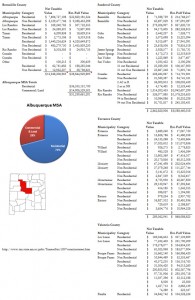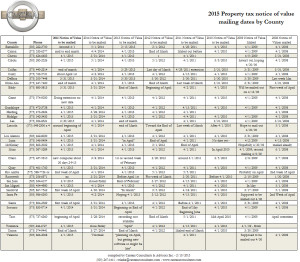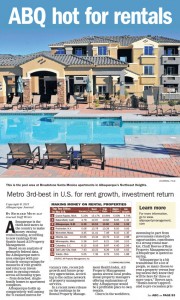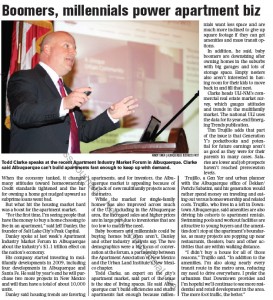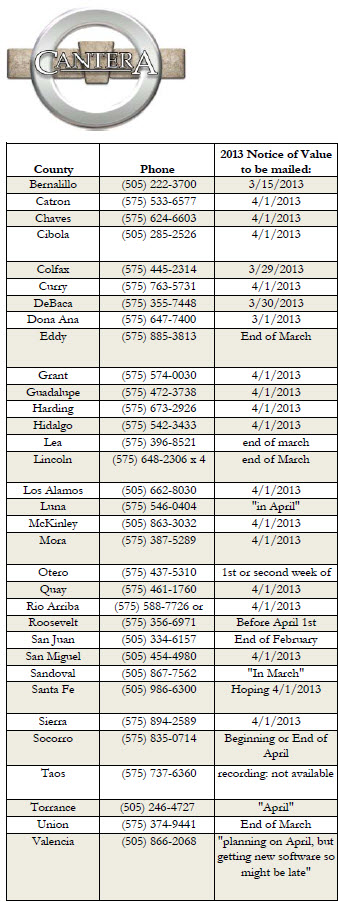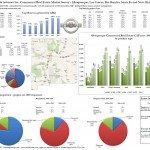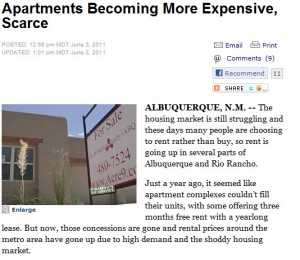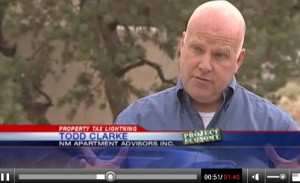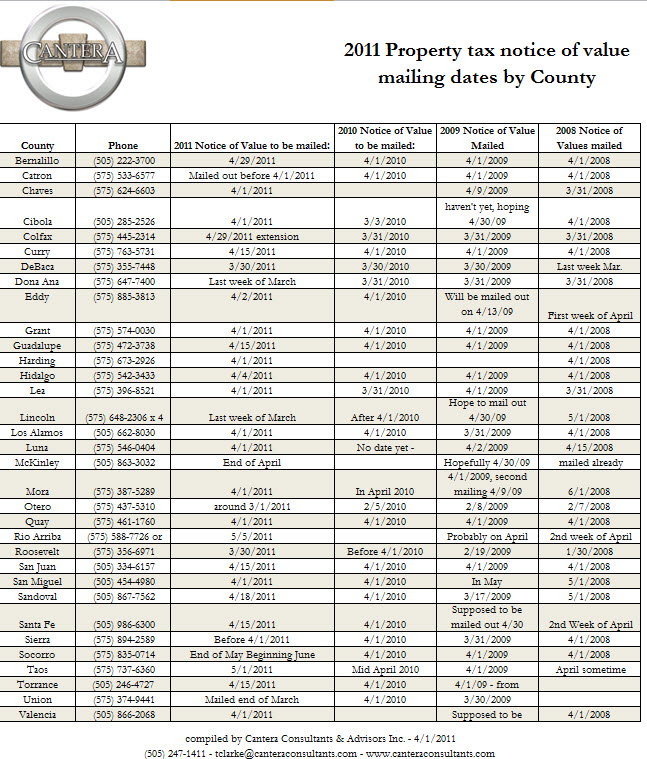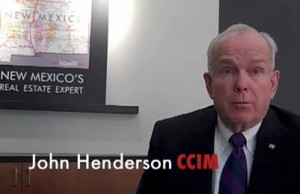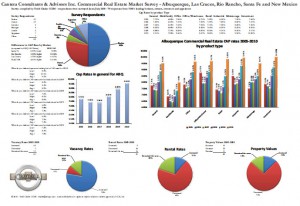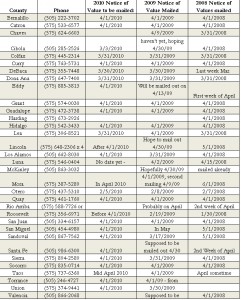Please note that the deadline to file a protest is 30 days after the date on the notice of value.
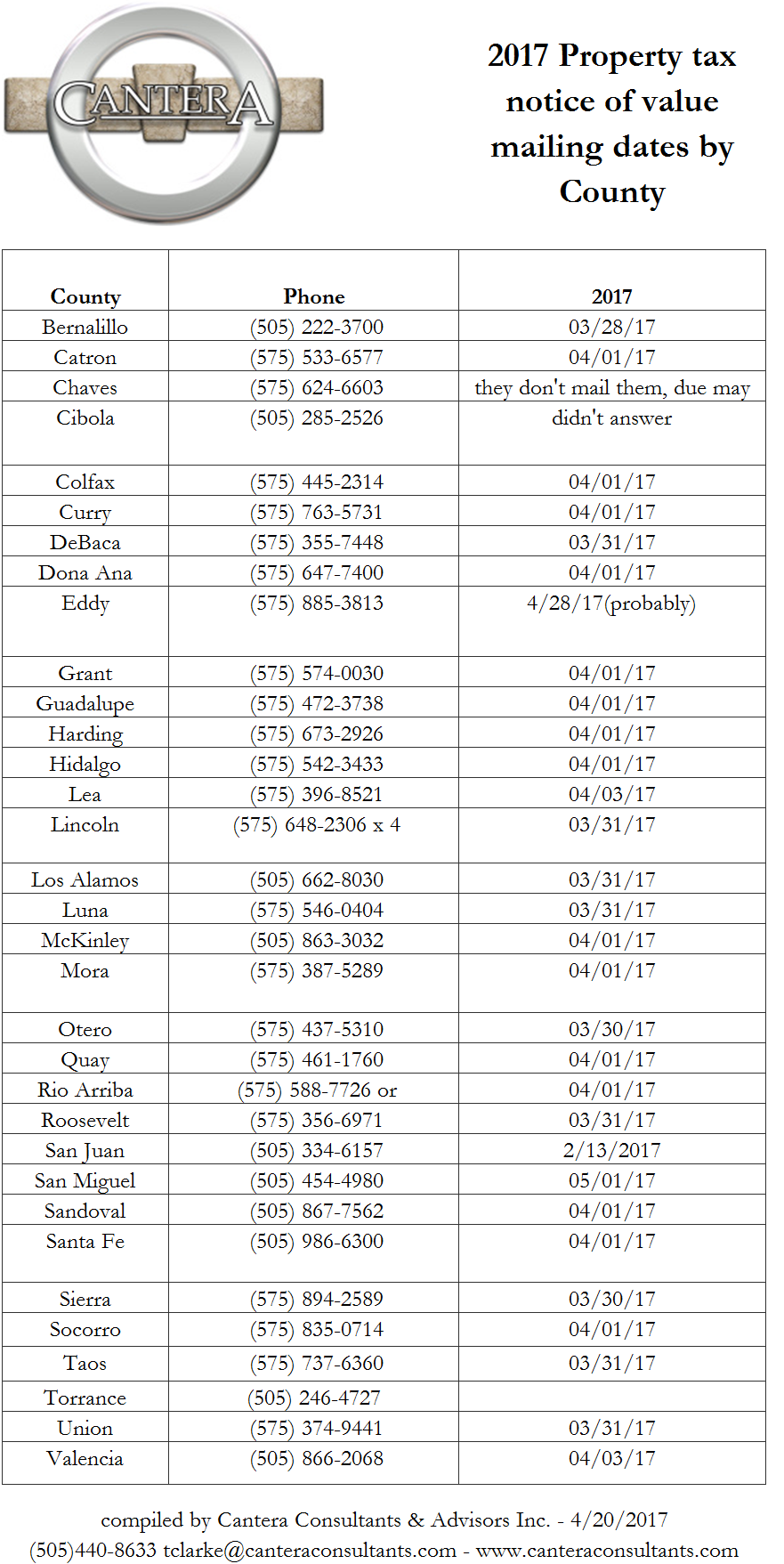
Category: New Mexico
Property Taxes – notice of values update for 2015
Cantera Consulants & Advisors has just updated its notice of value dates from each of the county assessors.
Please remember that you only have 30 days from the date of the notice of value to protest your property taxes.
A PDF version of this table can be found here.
State of the apartment market – 2014
NMREC mandatory course findings and update
Cantera Consultants and Advisors has just finished its analysis of the NM Real Estate Commissions mandatory course and E&O programs.
The findings and recommendations can be found here –
2-CCA2NMREC-UpdateandFindings-v9-
07202014
Albuquerque Hot for Rentals
In in Albuquerque Journal article dated October 8th, 2013, Albuquerque was rated the 3rd best market in the country for rent growth.
ULI NM – 2013 Commercial Real Estate Value Survey
The NM Chapter of the Urban Land Institute released its 2013 Commercial Real Estate and Value survey last week at the joint Apartment Association of NM and Urban Land Institute Market forum luncheon.
Previous value and cap rate surveys performed by Cantera Consultants & Advisors Inc. can be found here for 2011 and here for 2010.
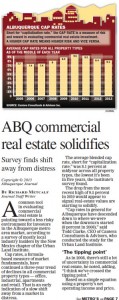 Read the full article from the ABQ Journal here
Read the full article from the ABQ Journal here
The complete 11 x 17 version of the survey can be found by clicking here.
ABQ Biz 1st – Boomers, Millennials power apartment biz
At the annual Apartment Association market update last week, Todd Clarke discussed the latest generational drivers of apartment demand. View the complete article by clicking here.
Property Tax Update
Spring is almost here, and that means its time to start looking in the mail for our notice of value property tax forms.
First on a macro level – the legislature is 12 days away from completing its 60 day session, and they are working on a couple of bills that could impact property owners.
House Bill 117 – appears to be DOA, and would have allowed a some disclosure to go into place – http://www.toddclarke.net/?p=1651
House Bill 521 – is working its way through various committees and currently has the support of RANM and the county assessors, but is being opposed by Apartment Association of NM which is attempting to make modifications to the bill – http://openstates.org/nm/bills/2013/HB521/documents/NMD00012252/
In it’s current form, HB 521 would not go into effect until 2014.
I recently taught the property tax course for a Santa Fe brokerage firm and they had invited two of the better county appraisers to attend. They were kind enough to share an interesting bit of info that should make tracking our notices of value easier – in 2014, notices of value should have a side by side comparison this years value vs. last years – an example can be found here – http://www.toddclarke.net/?p=1661
Notice of value dates
On a micro level – we have contacted all 33 assessors across the state as to their likely release dates for notices of value. A complete list can be found here – http://www.toddclarke.net/?p=1656 . Please note that their is an update for Bernalillo County (see below).
Changes at Bernalillo County
Although notices of value were prepared to go out earlier this year, Bernalillo County has a new assessor who has requested an extension until May 1st, 2013. For those of us who own commercial properties, their current valuation is in limbo as the commercial team is looking to hire a new commercial manager to provide direction for this years notices of value, all of which has led to a great deal of uncertainty as to what this means for values this year.
Class
If you need Continuing Education (CE) hours, or you think you would like to handle your own cases, we are offering our 8 hour “Understanding NM’s property tax system course” on 4/2/2013. The course is $99 if you use a PDF version of the textbook, or $149 if you need a printed one – seating is limited and registrations can be taken here – http://www.canteraconsultants.com/registration
As always, if you have any questions, please do not hesitate to contact me.
Thanks,
Todd
New Notices of value in 2014
Thanks to Gus in the Santa Fe County Assessor’s office for sharing the format of the new notices of value that should be standard in most counties in NM starting in 2014.
The major change is that these new notices of value now show your prior year valuation next to the current year, which allows the property owner to quickly identify an increase in property taxes due to value change.
A sample form can be found here.
SantaFeCounty-NewNoticeofValueForms-for2014-022013
The Santa Fe paper, the New Mexican, has reported this is part of a change in the law.
Notice of value dates for NM County Assessor’s
Our most recent survey of county assesor’s shows that most intend to send out notices of value on or before April 1st, 2013.
If you would like to compare these results with previous year – click here for our PDF version NM-CountyAssesorsNOVDates-2013-01242013 .
Legaslative update – NM Property taxes
Proposed Senate Bill 117 has been introduced (see attached) as a possible solution for property tax lightning.
The following represent my thoughts about this bill:
Currently this part of the state statues reads as follows:
PROPERTY TRANSFERS–COPIES OF DOCUMENTS TO BE FURNISHED TO ASSESSOR–PENALTY FOR VIOLATION
Whenever a deed or real estate contract transferring an interest in real property is received by a county clerk for recording, a copy of the deed or real estate contract shall be
given to the county assessor by the clerk.
A county clerk who willfully fails to comply with this section is guilty of a petty misdemeanor, punishable in accordance with the Criminal Code.
This was later updated for residential properties in 2004 (see bottom of this email for the gist of that change)
Although I would support a disclosure bill for all real estate in NM, this bill doesn’t do that, AND it creates less transparency that we currently have.
It also has a number of issues:
1. It conflicts with the current law for residential disclosure, which in itself has had a number of historical problems and issues (from the assessors and the property owners perspectives). A new bill should address those issues.
2. Limited use bill – for those that thought this bill might create a fairer system of values, it won’t, because it limits the assessors use to creating an summary index of value. My assumption is that the bills author hopes to use this to force the assessors to hit the “reset” button on all values by showing that their total portfolio is less than 85% of market value. That isn’t a bad idea, but it will lead to all values being increased. (removing the 3% cap on residential).
3. Most assessors lack resources (i.e. computer/GIS system) to comply with this bill. That in itself is a whole ‘nother box of pandoras as Former Govenor King would say.
4. Creates information that is not public information (what is the point of transparency if we allow the government to hide information) – this is a major problem as we have cases where the assessors has used an affidavit to support values in a formal hearing, but redacted the relevant information (because its not public), thus denying the property owner their right to correct bad information and the formal board has allowed the evidence to be used to force a higher value. Although I am sure it would never happen, a “lazy” appraiser could create an affidavit that has their target value, redacting everything else and the property owner would be defenseless to challenge that comparable sale.
5. The value language is a problem – I have a large 2012 apartment sale, where an escrow has been set aside for increased property taxes (same owner had the property for 25 years) – the language would require that escrow to be included in the calculation of value, even though it didn’t add value at all, but was rather a self financed insurance policy.
6. If we disclose price, we should also disclose size as that is relevant to value. And Zoning. and Use and Tenant info. and Financing. it takes the entire bundle to create value.
7. The bill lacks teeth for enforcement – what happens if we don’t file the affidavit? current law makes it a misdemeanor and $1,000 fine for each party (seller, buyer, title company). This net will capture the small property owner, but miss the larger institutional owners (as it does now).
8. It lacks verification – the bill should require that the affidavit be notarized as I’ve had several cases where a value affidavit has been presented, and no one has knowledge as to who actually signed it.
9. It creates unnecessary red tape and bureaucracy – what if the parties can’t agree on how to fill it out? Whose obligation is it really?
10. It requires the buyer and seller to agree on the allocation between real and personal property. This might seem like a small issue, but I’ve had buyers and sellers argue over whether 200 refrigerators are part of the real or seperate personal property. Currently, the system allows each party to make its own allocation.
11. Ultimately, what is the goal for this bill? I think if we knew that, we might know how to support them (or not).
Finally, if we decide to support it, I would recommend removing the emergency portion of the language. I have too many multifamily and commercial clients that could be impacted by this and they need to be able to plan for it in 2014, not be surprised as notice of values are being sent out in 2013. Along those lines, I’ve attached our latest survey of county by county and when notices of value are going out so we can see the impact it would have right now.
One more thought – I would run this by the title companies, to see if they would be willing to record deeds based on this (it increases their liability).
I’ve finally come around that transparency is key to a fairer property tax system, and if others are on the same band wagon, we would be better suited to draft our own bill and make sure it prohibits transfer taxes (NM had disclosure until 1970 and it was removed as part of the constitution rewrite to eliminate transfer taxes).
Thats all for today,
Todd Clarke CCIM
After January 1, 2004, New Mexico’s status as a “non-disclosure state” as relates to property sales data changed. Beginning in 2004 any person “presenting a deed, real estate contract,…” for recording with the county clerk is required to also file with the county assessor within thirty days of filing with the county clerk, an affidavit relating to the transfer. It is required that the affidavit contain the following information:
1. The names of the transferors and transferees
2. The current mailing address of both
3. The legal description of the parcel
4. The full consideration paid for the parcel
5. The value and a description of any personal property contained in the sale.
The law states that the assessor shall “…index the affidavits in a manner that permits cross-referencing to other records in the assessor’s office pertaining to the specific property” and “The affidavit and its contents are not part of the valuation record of the assessor”. This indicates, and some county assessors have stated, that the affidavit should not be used to increase the value of the subject property. The correct use of the affidavit then is as verified comparable sales data.
There are a number of exceptions to the requirement to provide the affidavit. In general these are for transfers that don’t represent what we think of as an actual, market conveyance of property. These exceptions include:
1. A deed that results from payment of a real estate contract
2. A lease or easement
3. A deed wherein the grantor is a government entity
4. A quitclaim deed to clear boundary disputes
5. A conveyance executed pursuant to a court order
6. A deed for am unpatented mining claims
7. An instrument solely to provide or release security for a debt
8. An instrument that confirms or corrects a previously recorded deed
9. An instrument between husband and wife or parent and child with only nominal consideration.
10. An instrument arising out of a tax sale
There are several others exceptions along these lines, including the conveyance of a property to a trust with the same ownership. A person who fails to file the affidavit in the required time frame, or who provides false information, is guilty of a misdemeanor and can be fined up to $1,000. As well, any employee, or former employee of the assessor who willfully releases this information is guilty of a misdemeanor and can be fined up to $1,000 per occurrence. An exemption is make for release of data as part of the formal protest process.
What is Residential?
Per the tax code, “residential property” means property consisting of one or more dwellings together with appurtenant structures, the land underlying both the dwellings and the appurtenant structures and a quantity of land reasonably necessary for parking and other uses that facilitate the use of the dwellings and appurtenant structures; as used in this subsection, “dwellings” includes both manufactured homes and other structures when used primarily for permanent human habitation, but the term does not include structures when used primarily for temporary or transient human habitation such as hotels, motels and similar structures;
That is clear for a single-family but what about a 20 unit apartment complex? What about a 200 unit complex?
THANKS TO NAIOP for getting the word out about this bill.
This is the kind of person I want looking after my states finances…
Yesterday’s Wall Street Journal reported that Susan Combs, Treasurer for the State of Texas is pushing for new legislation that would require local governments to add up their total debt obligations and disclose it to their constituents, the tax payer.
GREAT IDEA SUSAN!
Her office has also signed the light on Texas with a “Texas its your money” website that shares a ton of financial information about the states budgets.
New Mexican’s shouldn’t we demand the same?
Recent update on apartment property tax lightning
Both the Albuquerque Journal and 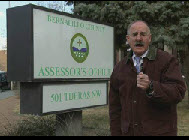 Channel 13 tv news have run recent overviews on the latest on apartment property tax lightning.
Channel 13 tv news have run recent overviews on the latest on apartment property tax lightning.
RANM course – 9/14/2012
This file is for the IRR course at the RANM conference 9/14/2012.
This is the file – filled out for a sample deal – IRR-Model-v12-FilledOutSampleDeal
And this is the file as a blank work sheet DTC-IRR-Model-v12-blank
Full agenda can be found here.
MFA Keynote presentation
NMMFA-HousingSummit-ResidentialUpdate-08222012-v2NMMFA’s keynote presentation for August 22nd, 2012 (4.5 meg PDF) “Matching Global Trends with Local Values”.
Rent vs. Own
Moment of NM Zen
I wanted to share this stunning video with you – this is one of the many reasons New Mexican’s love New Mexico!
Valuation survey for NM Commercial Real estate released.
Cantera Consultants & Advisors has just released its 2011 value survey for NM Commercial Real Estate. The survey reflects the collective wisdom of industry professionals in NM.
Although Cantera uses the survey primarily for the benefit of it’s during property tax protest hearings, the survey has become staple in the commercial real estate market and is widely used and quoted by many of the brokerage, appraisal firms and county assessors in NM.
The most interesting trend reported in this year’s survey is the indication that most of the commercial property types have turned the corner on decreasing values as CAP rates have started to decrease (slightly).
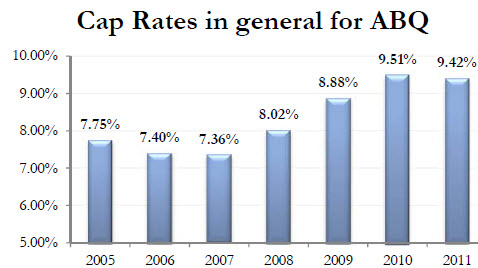
Tomorrow’s edition of the Business Outlook in the Albuquerque Journal will highlight information from the report.
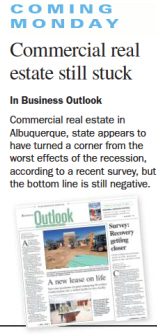
Last year’s survey results can be found here.
The 2011 value survey can be found CCA-Survey-10012011-v10.
Tapping into people’s memories as part of your social networking strategy
OR, using Groups effectively on Facebook.
As someone who has covered, spoken and taught courses on social networking, I can tell you this the fastest evolving part of the internet today. Facebook membership is rumored to be over 750 million people, or 20% of all of the business people on the internet today.
During the last few years I have seen mildly ineffective to downright disastrous uses of social networking, and the successful uses are fewer and far between.
Today I would like to focus on one of that success by focusing on a local Facebook group page that grew its membership from 30 to 15,000 and experienced over 40,000 posts in one weeks time.

The group Remember when in Albuquerque… had a simple concept – encourage local Albuquerque’s to share their memories of by gone places, people, and events.

The original idea came from Laura Reynolds, a Realtor in Las Cruces, who came across a Facebook group that allowed people who grew up in Ft. Worth to share memories. Laura suggested to her husband that he start a group about Albuquerque.
Steve started the group, Remember when in Albuquerque and quickly had 30 members. As those members started to tell their friends, and started posting their Albuquerque, memories, growth started to accumulate exponentially, and Steve requested a handful of us help administer (myself included).
I kept track twice a day of the growth of the group:
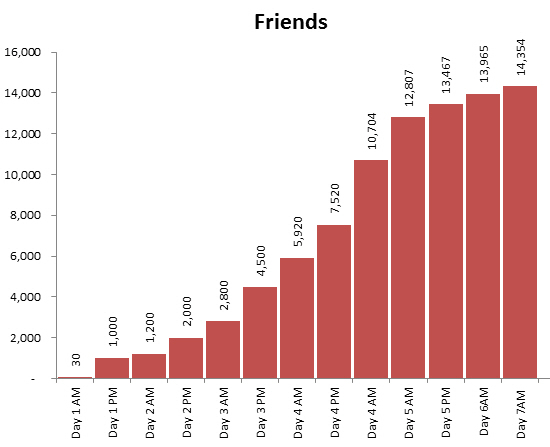
While the occasional commercial does popup on the group and there has been some sniping about deleted posts, the group has continued to grow as more people share their memories about Albuquerque.
Although many people know that four generations of my family has lived and worked in Albuquerque, many don’t know that I am an Albuquerque history buff and have a large collection of old photos, postcards and books. What better venue to share these? As I shared, others chimed in, and my “friends” counter increased by another 15% or so. (No, I don’t know all of them, but if they love Albuquerque history as much as I do, why would I tell them no?)
The group has received recent coverage from the local to TV new on KRQE as
As well as a front page article in the Albuquerque Journal:
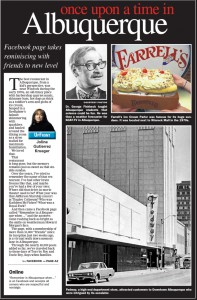
Is this a short term fad, or a long term trend?
For now, I would say long term trend. Although Facebook doesn’t share average time spent on any one group, a common expression from group members is how much fun they’ve had strolling down memory lane, and how much of their day has flown by.
Even after growth in the group stabilized at 15,000 (or so members), the media coverage has exposed the group to new people who are asking to join, creating that ever increasing spiral of increasing exposure, which is truly any marketers dream.
All in all, I’d label this a “sticky” success.
Apartments become more expensive
Thanks to Melissa Montoya for covering the latest in apartment trends on KOAT TV 7.
Apartment Property Tax Lightning
Thanks to Channel 7, KOAT TV, for running this story on apartment property tax lightning.
Property tax presentation for NM IREM Chapter
can be found here:
IREM-PropertyTaxUpdate-05052011-v2
thanks again to the IREM chapter for allowing me to provide them an update and overview of NM’s property tax system.
Bernalillo County property tax udpate for multifamily properties:
Earlier today, the Bernalillo County assessor announced that her office has sought and obtained approval to delay sending out notices of value for apartment buildings until June 15th, 2011.
This means the deadline to file a protest will be 30 days after that, or July 14th, 2011.
Single family and commercial property notice of values will be mailed out later this week with a deadline to file of May 30th, 2011.
As you know, last year was a tumultuous year for property taxes and apartments. Although our firm was able to obtain a significant reduction in apartment values, at the end of the day, this was done through strategy not a ruling from the formal tax board or the legal system. A legal ruling has yet to be made on whether apartments should have the same 3% cap as single family homes.
Those owners whose cases were not resolved are awaiting rulings from a handful of judges in district court. As was the case in previous years, it seems likely that one or two rulings will free up the balance of the pending litigation.
I would assume the assessor’s intent is to encourage one of the many judges to make a ruling prior to June 15th, 2011 deadline with the intent of using that ruling as direction for how to handle apartment values.
I believe this course of action is wise as it is going to take legislative, judicial or executive branch level action to correct the many property tax lightning issues.
Thanks,
Todd
It is property tax season
Notices of value are in the mail, or will soon be in the mail. If you need assitance this year with your property taxes – we offer a number of services for you, your firm and your client including:
We have an “app” for that
If you are trying to determining if your value is “fair”, consider downloading our 99 cent app from the iTunes store – http://itunes.apple.com/us/app/taxessor/id419811562?mt=8
Version 1 of the app takes the Bernalillo county resolved cases from 2010 and applies it to your property to help you determine what your value could have been. Because 2010 is a revaluation year, hopefully these values will go down. Version 2 of the app, which is awaiting approval of will automatically lookup your info from the county website and compare it to the potential value.
If you need some light reading, how about our 320 page textbook?
Now in its 5th edition, the text walks you through the property tax process including calculating your bill, determining if you should protest, and provides case studies of formal hearings and claim of refunds. Available in PDF format for $39 or printed for $49 at http://www.canteraconsultants.com/books
Property Tax Class – is on May 19th, 2011
This NMREC approved course is good for 8 CE credit hours and includes the above mentioned app and textbook and provides hands on training on how to handle your protest and covers our everything you need to “understand NM’s Property Tax System” – course registration for the 5/19/2011 course can be made at – http://www.canteraconsultants.com/registration
Representation
Finally, if that all sounds like a lot of work, you can hire our firm to represent you. We will analyze your property for free, and we charge you a small percentage of the savings only in the first year we obtain a reduction. Over the last 22 years, we’ve won 97% of our cases, representing over a billion dollars of commercial real estate with an average reduction of 23%. We charge 1/3 of what we save the client (i.e if we reduce their property tax bill by $10,000 then we charge $3,333) and we pay a 25% referral fee (on what we collect) to licensed agents, property managers or Realtors. If they choose to waive the referral fee, we can reduce our fee to 25% of the savings, and let the client know why they received a special discount.
If you have a property tax problem, look to us to be your solution.
Notice of value dates for property tax bills
A new form of advertising – your house
Thanks to Gizmodo.com for sharing from Adzookie.com which is a UK based company that is offering to pay homeowners mortgages if they let them paint their house with advertisements.
Although the Gizmodo posting indicates the advertisement is only in UK, when I went to their website it looks like they are up and running in the USA as well!
my first iPhone app help client’s calculate their property taxes
Very excited – as of 5 minutes ago, our iPhone app to help client’s calculate their property taxes for commercial properties in Bernalillo County went “live” in the iTunes store! It is only 99 cents, and if you provide us feedback to improve version 2 and leave feedback, I’ll gladly send you a buck!
If you own a commercial property in Bernalillo County and you would like to compare your property’s value against the resolved cases from 2010, click here – http://itunes.apple.com/us/app/taxessor/id419811562?mt=8 to try it out.
The App is only $.99 and if you leave us a review and email me feedback at tclarke@nmapartment.com so we can improve version 2, I’ll gladly refund you a buck.
Thanks to Mark and Jamii at SWCP for making this happen.
Support for the app can be found here – http://www.taxessor.com .
Homeless survey in Albuquerque – Day 1
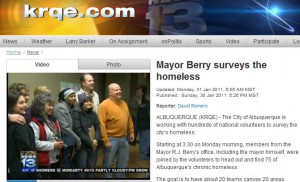
This morning starting at 4am, hundreds of volunteers, including Mayor Barry and his wife, scoured the city looking to survey the homeless and put a face with the statistics of being without a home.
As part of the 100khomes project, Albuquerque has created ABQheadinghome or Twitter
KRQE ran a full story this morning which can be found here.
I surveyed one individual who has been living in a makeshift tent in an arroyo on the west mesa. He has been homeless 7 months, and was recently attacked by three individuals who wanted his possessions. The attack was so brutal he was hospitalized and ended up receiving titanium plates in his head.

There has to be a better way to take care of all people who live here…this group seems determined to find it.
Update: Day 2– below freezing temperatures, blanked of snow on the westside, I was fortunate to be put on good friend (and City Councilor) Trudy Jones team – we introduced “Mike” who spent the night tented in highway culdesac.

The people on our Day 2 team were simply amazing – they knew the people we interviewed on a first name basis and made the process very comfortable for everyone.
Update: Day 3– the Mayor has announced that this survey has turned into a rescue misssion and the city is workign with APS to open up high school gyms for shelter from the unsually cold winter. Councilor Jones is raising money to feed the homeless, and United Way (and others) have raised over $50,000 in less than 48 hours.
It is one of the few times I’ve been speechless by the giving of others and honored to be a small part of the process.
CCIM Success Profiles – one of my mentors, John Henderson III CCIM
As you may know, the NM CCIM chapter #10 is collecting a series of stories about some of their most successful members – a task called “profiles in success”.
Many of us have had people in our lives who we are grateful for – persons who show up at the right time and point us in a new direction, or people that provide invaluable insight that changes our course for the better.
I am a 4th generation Commercial Realtor, and both of my parents were in the business and provided that role for me.
In addition to that, I’ve been fortunate enough to grow up in a business and community of individuals that lean towards sharing, supporting, who focus on growing the pie instead of figuring out how to make their own piece larger.
In turns out that isn’t by accident, but was by design. Over 30 years ago, a handful of commercial brokers assembled at one of the earliest meetings of the Leasing Information Network (now known as LIN). Like our country’s founding fathers, these brokers set down their ideals of how people in our business would interact. Cooperation was the key word of the day, with the idea that fees and information would be pulled out of individual silos and shared by all.
One of those leaders, John Henderson III CCIM, was an early mentor for me. I remember when I was a teenager John tactfully informed me that my personality could be improved by attending a Dale Carnegie course (he was right). When I started commercial real estate in 1989, John encouraged me to take a CCIM intro course as soon as possible, and like him, once I had the knowledge, I couldn’t stop. John went on to write a letter of support that helped me secure a CCIM 101 scholarship, and for me, the rest is history as CCIM has done more for my business than any other aspect of my life.
With that thought in mind, it is my pleasure to share this video about John’s start in the business – some 40 years ago, John Henderson was a successfully residential Realtor, whose own life would be changed by a mentor to him.
More on John’s beginning in commercial real estate can be found here at his video – http://www.nmcomreal.com/ccimintro2 .
If after hearing these stories, you believe you might benefit from taking a CCIM course – the local chapter has an intro course this on February 7th and 8th – for $245, a 43% discount over the national rate. You can register for the course at www.nmcomreal.com/ccim .
Thanks,
Todd
Interested in becoming a CCIM?

CARNM’s most recent award winning Realtor, Lia Armstrong CCIM, was kind enough to share what the CCIM program has meant for her- watch the YouTube Video.
Save your seat for the February 7-8, 2011 course by registering here.
Filing a claim of refund for 2010 property taxes
After many months of strategizing, negotiating, researching, and putting together our cases for our client’s, Cantera Consultants & Advisors Inc. recently settled all of its cases on the controversial apartment property tax lightning cases for 2010 (click here to read the summary).
In a recent (and copyrighted) Albuquerque Journal article, The Bernalillo County Assessor has indicated that she intends to roll back the 2010 values on all apartments that were raised more than 3% over their 2009 values.
If you own an apartment that experienced an increased of more than 3% in value (over 2009), and you did not file a protest by May 20th of 2010, there is one additional option available to reduce your property taxes for 2010 – you can file a claim of refund.
While this is a normal a service we offer our clients for contingency fee, in this unique situation, I believe the work we (and others) have done for our client’s this year has laid the foundation for the remaining apartment owners who haven’t filed to seek a refund.
If you meet the following criteria, you might be able to handle this case yourself:
– If you are the owner of a property not held in a partnership or corporation, you can represent yourself at district court to seek a refund of your property taxes.
– If you have already paid your property taxes, the full amount (not the first half installment)
– If you fill out a claim of refund (again, its more than a form, it is a lawsuit)
– If you file, in person, and pay the filing fee
In New Mexico, a claim of refund is lawsuit against the county, in which you, as the property owner, claim that you have overpaid the county in property taxes.
While I am not an attorney, and cannot offer any legal advice, I have been involved in a handful of claim of refunds and I can tell you that you can go to the district court website at www.nmcourts.gov and search the cases for the name “Karen Montoya” (our current assessor) and request a copy of a claim of refund from the court (you must do so in person, and they will charge you a copy fee) and use it as a model for your claim of refund.
You can also download Chapter 11 of our book “Understanding NM’s Property Tax System -2010 edition” that includes a blank form that we’ve used before. The deadline to file the lawsuit is 60 days after the property tax bills were sent out.
When filling out the form – be sure and look up your property’s property tax bill information at Bernalillo County’s website. Part of the form requires that you calculate what your property tax bill should be (based on 2009 values + 3%) vs. what it was on the actual tax bill.
Most tax consultants, such as our selves, are also working with attorneys and can provide assistance, but this maybe one of the rare situations, where everything has already been resolved (thanks to those owners who filed protest, and there consultants/attorneys who worked through the cases in 2010), that an owner maybe able to simply handle this themselves.
****disclaimer – in case I haven’t made it totally clear – this information is provided as a public service, and it not intended to offer legal or real estate advice. Going to court without legal representation is not a wise idea.
Property Tax protests update for 2010
2010 Bernalillo County Multi-family Property tax rollback – the rest of the story.
The following is a summary of an email sent to clients after our December 15th, 2010 hearing:
As I was working through a review and update of the apartment property tax lightning cases of 2010, I was reminded of the ancient Chinese blessing (or curse depending on your viewpoint):
“May you live in interesting times”
Many people are not aware that this blessing has two follow-up lines:
“May you come to the attention of the authorities” and
“May you come to find what you are looking for”
Unfortunately, 2010 was a year where all three of these came true for many of us. With that in mind, The following is an update on the property tax protests for your property.
The short version of this update is simple: we were able to get your property the lowest value we believe was possible in 2010, that value is final, and is not subject to any further litigation or appeals.
The long version as follows:
In my 22 years of handling property tax protests, 2010 was a unique year. State statutes indicate that the “value” year was 2007, which represent the tail end of the peak in the real estate market, and yet here in 2010, values in many cases had plummeted. We can add to that mix a county assessor who had recently been told by two different judges in district court that parts of a law passed by the legislature in 2002, and enforced by 33 county assessors was unconstitutional. As these recent changes in the law have had a big impact on how properties are valued, and it would be a safe to say this was a “perfect storm” that could wipe many property owners out.
Why we believe our client’s hire us at Cantera Consultants & Advisors Inc.
As it relates to handling property tax protests for our clients, we have found that successful protests involve more than knowing valuation technique and state statutes, it is also about knowing the people and having a strategy.
Our strategy this year was as follows:
– To use time to the advantage of our clients
– To research, develop, or create market information for the foundation of value negotiations
– To provide our clients with the risk/return analysis of the values that were negotiated with the assessor’s appraisers
– To meet with our local politicians, keep abreast of the recent changes in law, and provide an continual education on our property tax system
– To keep our clients and the public informed as to the changes in the property tax arena
– To align ourselves with other professionals who have experience in the property tax protest arena and litigation (i.e. find a good attorney)
Market information
For the first time ever, our firm, Cantera Consultants and Advisor Inc., compiled a 5 year survey of occupancy, rental rates, CAP rates and value changes. This market information was published in the Albuquerque Journal earlier this year and was used to help our client’s in obtaining lower property tax values.
A bit of history about recent changes in the law
The law, known as the “property tax lighting” or “3% maximum increase” or “3% Cap on values” law limited the increase in values for residential properties by no more than 3%. What many people forget is that the law had other components, such as requiring all assessor’s to bring their entire portfolio to “current and correct values, which are to be no lower than 85% of market value” prior to implementing the cap.
The intention of this law was to minimize the impact of a property tax bill increase on the little old lady in Santa Fe whose neighborhood was being overrun by Hollywood types that were paying outlandish in prices for housing. The value of the little old lady’s house would rise to the recent sales, which would lead to an increase in her property tax bill to an amount she might not be able to afford.
While the intention of the law might have been noble, the thought process about how to implement it was poorly executed. If we as citizens of New Mexico have decided that the little old lady deserved protection, then the legislature could have granted her an exemption on her actual property tax bill. Instead, the law limited the increase of her assessed value by no more than 3% a year, or 6.1% every 2 years.
Anyone who has analyzed our property tax system knows that there are three variables that impact your final property tax bill. Your assessed value, the percentage of your property that is assessed, and the mill levy. In New Mexico, your assessed value should be close to “market value”, most properties are assessed at 1/3 of their market value, and the mill levy floats as a ratio between the county’s total property portfolio value and the budgets of those entities that tap into property taxes.
By limiting only the value of the property, the law did not limit the increases on the property tax bill. By requiring disclosure of all single family residential property sales, the law ensured the assessor had a ready pool of comparable sales, AND, many of us believed it opened the door for the legislature to consider a property transfer tax.
The law had some exemptions that allowed increases of more than 3%, including new construction, changes in zoning, and the sale of the property. If your property had experienced any of these, its value could be increased by more than 3%.
As property buyers came into title in their new property, they experienced a large increase in values, larger than the 3% of previous years, which led to the term of “property tax lightning” for the zapped feeling many of these owners experienced as their property tax bills shot through the roof.
From 2002 to 2009, residential property owners were repeatedly zapped with this unfair law. Typically, case law, or interpretation of laws in the court room allows our legal system to provide a balance against our legislature. Amazingly, it took a few years before a case was filed that impacted the interpretation of this law.
In 2009, a handful of property tax cases were brought against the Bernalillo County challenging the implementation of the exceptions to increasing values more than 3%. Two different judges ruled that the law was unconstitutional, and those cases have since been appealed, and now, on the eve of 2011, have still not been resolved.
Resolution or not, the message was clear – the legislature created a law that treated property tax owners differently based on the date of their purchase of a property.
At the end of 2009, and after these court rulings, the county assessor “rolled back” all single family home values that had been increased by more than 3% to their 3% limits.
As a side note – it is interesting to note that a legal opinion written about the same time as the law was being considered by the New Mexico Attorney general indicated that the while this new law may not be unconstitutional, “its application could be unconstitutional”.
Fast forward to spring of 2010, where the Bernalillo County assessor has two rulings that the 3% cap on increase law is unconstitutional. She decides to rolls back the value on some 45,000 single family homes that had experienced property tax lightning in former years.
As the overall value of the county’s portfolio is decreased by these roll backs, she also interprets that the law on limiting increase does not apply to apartment buildings based on their occupancy status and then she proceeds to raise the value on thousands of apartments across the county.
Although the decrease in single family values was not entirely offset by the increase in multifamily values, the timing of the two cannot be entirely coincidental.
Through out the summer, fall and winter of 2010, our office met with the county assessor’s appraisers and reviewed each of our client’s properties. In many cases, we were able to get a value reduction to the 2009 value plus 3%, or lower.
In some cases, we were able to get the value’s negotiated down close to the 2009 level +3%, and we signed off on those cases. Working with our client’s we performed a risk/return analysis that balanced an additional smaller decrease in value vs. the possibility of paying a property tax bill on the original assessed amount for many years as the cases worked their way through the property tax protest process and possible appeals into the legal system (keep in mind, those owners who prevailed in the 2009 single family property tax lightning cases are still paying higher property tax bills in 2009 and 2010 as their cases are still under appeal).
The balance of the property cases we had, totaling 30 in number, proceeded to formal hearings on December 15th, 2010. These were the most hard core cases, where none of the standard value techniques indicated a value remotely close to the 2009 plus 3%. In one particular case, while we able to reduce a property’s value by 50% from its 2010 assessment, the 2009 value plus 3% was another 50% lower. Each of these owner’s (including myself) indicated an ability to pay the higher property tax bill and a desire to continue their protest based solely on the legality of the removal of the 3% increase in values.
Assessor’s deposition
On November 19th, 2010, the Bernalillo County assessor was deposed by a handful of attorneys, including ours. I attended a majority of the deposition and I can tell you my summary at the time was that the most repeated answer in the 167 pages of the deposition, was “I don’t know”. Part of that consistent answer relates to the questions that some of the other attorneys asked – questions that showed a limited understanding of the assessor’s job duties, but the balance of the questions related to the assessor’s execution of the changes in values to apartments as it related to the removal of the 3% increase cap on values.
As you may know, there is a state statute that gives any county assessor a large advantage in formal hearings:
7-38-6. PRESUMPTION OF CORRECTNESS
Values of property for property taxation purposes determined by the department or the county assessor are presumed to be correct. Determinations of tax rates, classification, allocations of net taxable values of property to governmental units and the computation and determination of property taxes made by the officer or agency responsible there for under the Property Tax Code are presumed to be correct.Our belief was that the assessor’s deposition demonstrated that this presumption of correctness should not be applied by the formal tax board in these apartment cases.
Timing
Based on last year’s single family property tax lightning cases, and our experience from previous years, we believe the longer we can wait to resolve our cases, the more our client’s benefit. For example, last year, some of our clients benefitted from recent court rulings that came late in the year. Said succinctly, each year the aggregate protests carry with them a body of knowledge, and by being last or close to last in the protest process, we benefit from that knowledge base.
The unfortunate side effect of waiting until the end is that the assessor was successful in getting an extension of their cases until after the December 10, 2010 property tax bills were due, so many of our clients received a bill for full value.
Our formal hearings for unresolved cases were scheduled for December 15th, 2010.
Ostrowski Decision
On November 30th of 2010, the formal property tax board found in favor of a property owner who owned a single family residential property that was rented out. The property in this case had sold in 2004, and had been hit with tax lighting, but its value was not rolled back as it was believed to be a “non-owner occupant” property. The board ruled that irrespective of the property’s occupancy status, it was not being treated uniformly with other similar properties. The board ruled that the value be rolled back.
Owings Star decision
On December 3rd, 2010, the formal property tax board found in favor of the county assessor in a case where an apartment owner believed that their property had been discriminated against based on its increase value of 25%. Unfortunately, the owner presented little in evidence to demonstrate said discrimination, and the formal property tax board, citing the case Hahn, Inc. vs. County Assessor that “the bar is set very high for a property owner claiming discrimination. What must be proven is an intentional scheme of discrimination, for which there is no evidence here”, and the formal board found in favor of the assessor.
Unresolved Decision
On December 9th, 2010, the formal tax board convened to hear the 40+ cases of another tax consultant and his attorney. Although the assessor had been subpoenaed to appear, the county attorney informed the board that she would not be appearing, and that the consultant, and their respective property tax owners, did not have the authority to subpoena an assessor to appear. Both sides tendered their briefs and this case should be ruled on by January 8th, 2011.
Clarke Stipulation
About a week before the hearing, our attorney, Stephanie Dzur (who prevailed in the single family residential property tax lightning cases in 2009), extended an offer to the county attorney’s office. The offer was an agreement that indicated we understood that the county assessor has been making decisions based on the information available at the time, and while we respected the difficult position she was in, we believed we would prevail at formal hearings, and as such, the county should agree to rolling back all of our pending protests to the 2009 values plus a 3% increase. As part of this offer, Mrs. Dzur shared with the county assessor our case, which we believed to be very strong.
Wednesday, December 15th, was our formal hearing for all remaining property tax protests for Bernalillo County. By Tuesday afternoon, we had been able to negotiate all of our pending cases down to the lowest values, subject only to the apartment cases that has experienced “tax lightning” or an increase of more than 3%.
Wednesday morning, I received a call from the assessor and she indicated that she wanted to meet with myself, the county attorney, and our attorney, Stephanie Dzur. The assessor indicated that based on how the formal board was ruling, she believed that apartments should not be treated differently, and although she intended to appeal some of the formal rulings, she was willing to resolve and sign off on the balance of cases if we could come to terms on a stipulated agreement.
Over the course of the morning, we modified the language of our original stipulation presented in our offer the week before.
Although we had an intellectual interest in pursuing the case through formal boards and a passion to put on our case, foremost in our minds was the issue of an appeal. The assessor had indicated that she was going to appeal the decision of the formal tax board, and similar to the property tax lighting cases of 2009, we were concerned that our client’s would be exposed to many years of property tax bills based on much higher amounts, until the legal system could provide a final and complete ruling.
By working through the stipulated agreement, you and our other clients would benefit from a lower property tax bill and a final decision that was not appealable. For each property that was subject to this agreement, I have already forwarded to you the stipulated agreement. The gist of it is that we agreed that the assessor interpreted the law based on the best information she had at the time, that the information was changing over time, and that we wanted our clients to benefit from that updated information by being treated the same as other the residential properties in 2010.
In the end, we believe we had the better hand, the better case, and that it led to the best possible outcome.
2011 and beyond
Many of our client have asked us what 2011 will hold, and to be candid, while I have many ideas as to what might come about with a new governor, a “refreshed” legislature, and an reelected assessor, I remain hopeful that they will have the courage to deal with this pressing issue head-on.
My largest concern for future years is the creeping of politics in the property tax system. In his autobiography, Former Governor King indicated that one of the many reasons he wanted the state constitution rewritten in the 1970’s was to push politics out of the property tax system. The laws that came out of that constitutional congress served our state well for over three decades, but all of that effort has been undone by recent laws. Until we repeal those laws, or modify our property tax system I remain concerned that politics and politicians will continue to provide uncertainty in our property tax system. That uncertainty translates to an opaque property tax system that will have an impact on all of our property values.
Fortunately, organizations like the Apartment Association of New Mexico and NAIOP are staying on top of these issues by meeting with our elected leaders to provide a better outcome. If you are not currently a member of both of these organizations, I would highly recommend signing up in 2011.
My apologies for the lengthy update, but I thought you might have an interest in the rest of the story. If you have an interest in copies of any of the above mentioned documents, don’t hesitate to let me know.
Thanks,
Todd
————————-
Todd Clarke CCIM
Cantera Consultants & Advisors Inc.
715 8th NW Albuquerque NM 87102
O 505-247-1411
M 505-440-TODD
F 800-791-4047
tclarke@nmapartment.com
www.nmapartment.com
Read Confessions of a Commercial Real Estate Consultant – www.toddclarke.com
————————-
770 KKOB Radio update – 11/29/2010 – Forecasting real estate in 2011
Bob: what do you have for us today Todd
Todd: Good morning Bob! It’s hard to believe the holidays are already upon us and before you know it the end of the year will be here. As that time approaches, many of our customers wonder what 2011 will hold for the real estate industry and whether NM’s real estate market will lead, follow or diverge from national trends.
Bob: Todd, do you have a forecasting resource to help answer these question?
Todd: We sure do Bob, our firm has followed a publication called “the Emerging Trends in Real Estate” which is published by the Urban Land Institute and Price/Waterhouse/Coopers. For 32 years the authors of this publication have called upon the leading experts in the real estate industry to ask them what they see in their business in the coming year. This report provides an outlook on U.S. investment and development trends, real estate finance and capital markets, with a focus on key property sectors. The report draws on formal and informal surveys of real estate executives, investors, developers, and market experts around the U.S., including survey responses from over 500 real estate executives and personal interviews with over 125 industry leaders.
Bob: Sounds very comprehensive Todd, where can our listeners get a copy?
Todd: Bob there are two ways to get a copy – you can join the Urban Land Institute at www.uli.org, OR, you can attend their “Outlook NM” event to be held on the evening of December 9th, 2010
Bob: Can you tell me a bit more about this event?
Todd: I sure can – the national speaker is Chuck DiRocco from Price/Waterhouse/Cooper and he will be followed by our local panelists, Steve Maestas at Maestas Ward who will talk about retail, John Ranson of Grubb & Ellis who will address Office and Industrial, Jim Folkman of the HomeBuilders of Central NM who will discuss the single family residential market, and I will be covering the apartment industry.
Bob: Sounds like a full event – how can our listeners participate?
Todd: The cost of the event, which includes the publication is $60 – to RSVP – call the local Urban Land Institute office 505-269-7695 or call me anytime at 440-TODD.
Candid advertising
In case you can’t read it – it says “your art might suck, but your studio doesn’t have to”.
Advertising live/work/walk studios adjacent to the main square in Taos, the Central Station Taos wins our award this month for being brutally frank.
NM Commercial Real Estate Value Survey
Cantera Consultants & Advisors has just released the results from our latest valuation survey. This survey was performed over the summer of 2010 with real estate owners, investors, lenders, brokers and appraisers.
The attached document demonstrates the changes in CAP rates and values from 2005 to 2010.
Click here for the survey results and a related newspaper article CCA-Survey-07092010-v8plusJournalArticle
NM Notices of property tax value are being mailed out
Bernalillo County is mailng out notices of value on April 1st, 2010 and the deadline to file a protest of value will be 30 days after that.
The remaining 32 counties have indicated that this is there mailing schedule:
Our firm offers three options to assist you in property tax protests:
1. buy our 250+ page, fourth edition text book – click here to order for $49.
2. attend our “Understanding NM’s Property Tax System” course on April 15th, 2010 – you can register by clicking here.
3. hire our firm to represent you on a contigency basis – email tclarke@nmapartment.com or call 440-TODD (8633) for more info.
The potential impact of upcoming legislative and legal changes on NM’s Property Tax System
I think of our property tax system as a bit of a prisoner’s dilemma (that is the game theory where two suspects are picked up by the police – if they both refuse to cooperate they walk, if either turns on the other suspect, then other suspect goes to jail, and if they both turn in the other, they both go to jail). Applying that to our property tax system, I believe that most property owners want a fair system, but so long as there are loopholes or the perception of unfairness, than they too want that loop hole – the end game of which is a downward spiral in tax revenues.
Personally, I believe in supporting the person who has the right ideas over a party ideology– and former Governor King is just such a person – in the early 1970s he had the state constitution rewritten, in part to deal with the inequities in the property tax system (it was common for your political affiliation to dictate how high or low your property taxes are). So whenever I contemplate changes to the property tax law, I think, what would Gov. King look for that would create a fair equitable system.
Although our property tax system has a lot of “fairness” built into it, simple it isn’t. This flow chart shows how the property tax system works and who can influence it.
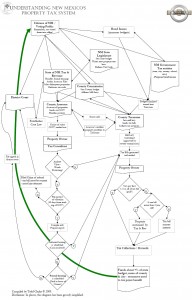
If I grossly simplify that process, there are four places to influence the final tax bill:
- The property value
- The % of that property value that is assessed (current 1/3)
- Deduction for any exemptions
- Mill levy (which is calculated by taking the total budget for taxing entities and dividing that by net taxable value for each county’s portfolio)
So simply said, our tax bill is calculated by taking:
Property value x % of assessment – allowed deductions = net taxable value x mill levy.
By having the law focus on only property value, it is possible to have no net change on the tax payers final properly tax bill. For example – if we had a law that said every property would double in value (say to reflect true market conditions) in 2010, then net impact on the tax bill would be no net change. (When you double the values, you halve the mill levy).
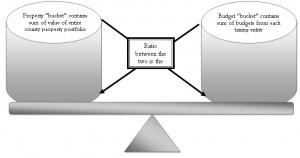
So in dealing with the two issues of tax lightning and fairness, my own personal belief is:
- At the time, (I was on a panel with him when he said this), the original intent of the Santa Fe assessor who wrote the some-what-disclosure & 3% cap law, he did so with the intent to protect the little old lady who has had the same house for 100+ years in Santa Fe – the idea was to keep her property taxes down even when the values were being pushed up by the Hollywood crowd moving into her neighborhood. This could have been handled through an exemption (like we do for Veterans and head of household, etc.), and we wouldn’t have the issues we do now. If the law was turned into the protecting the little old lady law through exemption, but it kept her property value
- I believe his true intent was to push through sales disclosure. The way the law was written, if an assessor disclosed information that had been disclosed to them, for every incident of disclosure, they were liable for a $1,000 fine, but the tax protest process requires the assessor to provide the protestant with complete copies of info (covered under part of the state statutes that deal with disclosure in court cases) – so I file a protest, the assessor uses 6 comparable sales that were disclosed to them by a property owner and that property owner could sue them for $6,000 – many of the 33 assessor’s were scared of this law and how to protect property info (I know of a county down south where you could “purchase” the assessor’s data set for a nominal amount of money).
- The 3% CAP was only supposed to protect the little old lady, not the average home owner, and certainly not the large apartment owner (22 counties consider apartments residential, 10 consider them commercial, and 1 just doesn’t know). BUT now that the law exists, I have been able to get my large apartment owners the same protection (no increase in value and a 3% CAP) – and as much as I love my industry, that just isn’t fair for our community.
- So looking at the law from every angle, there is no piece of the original legislation that provides transparency or disclosure.
- For residential, the law should be repealed entirely. The 3% CAP distorts everyone’s property taxes (when California passed proposition 13 (basically a limit on property tax increases), that state when from one of the best in schools and infrastructures to one of the worse.
- The commercial property owner and broker just isn’t paying attention – for example, let’s say you own a property in Rio Rancho – last year the residential property owners (who live in Sandoval County) voted to effectively double their mill rate by taxing themselves for a new college and hospital. The non-voting commercial property owner is now receiving a tax bill for $40,000 instead of $20,000 which has decreased their property value (in the short term at least) by $500,000 (8% CAP rate) or 20% of its original value of $2.5M.
- Furthermore, as the residential values decrease through the 3% CAP, the commercial property bears the burden of taxation. Although this next example is a different expense item, but it illustrates the unintended changes caused by new laws – in Florida, to reduce insurance costs, the legislature shifted more of the burden from residential to commercial – so much so that a 1,000 unit development project I worked on had a insurance bill as an apartment (commercial) that was 10 times higher ($2M) than if it was a condo (residential) which would have an insurance bill of $200,000. The Caps on increases of value for one property class will cause the same distortion.
- As it relates to newly developed properties – I have a client who tried to build a 300+ unit new construction apartment on Albuquerque’s Westside – its likely value was going to be lead to a tax bill that was 3.5 times higher than similar properties that had been built in previous years (which were subject to a CAP as well) – so the existing property owner had an unfair competitive advantage that caused this apartment not to be developed. To fix that, I think we would need a system where by new construction is phased in over 3 years to its full value AND we need a system that allows all property’s to be raised to their full value
- FAs it relates to bond issues, I believe when the voters vote, they need to understand that while their property taxes may (or may not) go up, by declining a bond issue, their property taxes could go down. Said another way if the ballot said “would you vote for a new library knowing that it would raise your property taxes by $40 a year for every $100,000 in value your house had (Y/N).” Then the tax payer/voter could consider the value the said public amenity (road, library, school, hospital, etc) adds to their community. Further consideration would have to be given to whether commercial benefits from every public service (fire/police= yes, library/school-no) and how we accommodate for that.
Finally, to have a fully fair and equitable process, any future laws need to model the impact on values based on the current mill levy, % of value, and property value and the outcome needs to be one where we can:
- Explain it to a new buyer or developer (for example – your property tax bill will likely be 1% of what you pay)
- Is transparent in operation (if I showed you the inequities in what we have now, and the loopholes that I as a tax consultant can use, you would be amazed at the lack of transparency)
- Is as fair as possible (i.e. you could look at your neighbor’s property tax bills and understand why they are similar (in value) or dissimilar (in exemption) as yours)
- Does it eliminate the abuse of unintended loophole as possible (when I was in China, they had a property tax that said you would only be taxed if your property was 100% complete – guess how many 40 story hi-rises I saw with an unfinished floor?)
